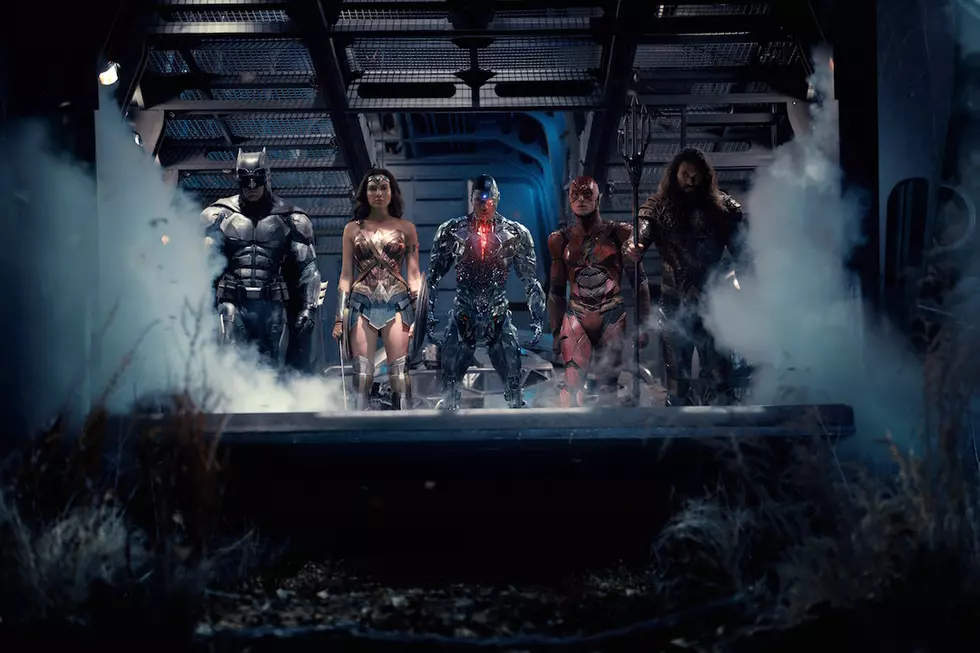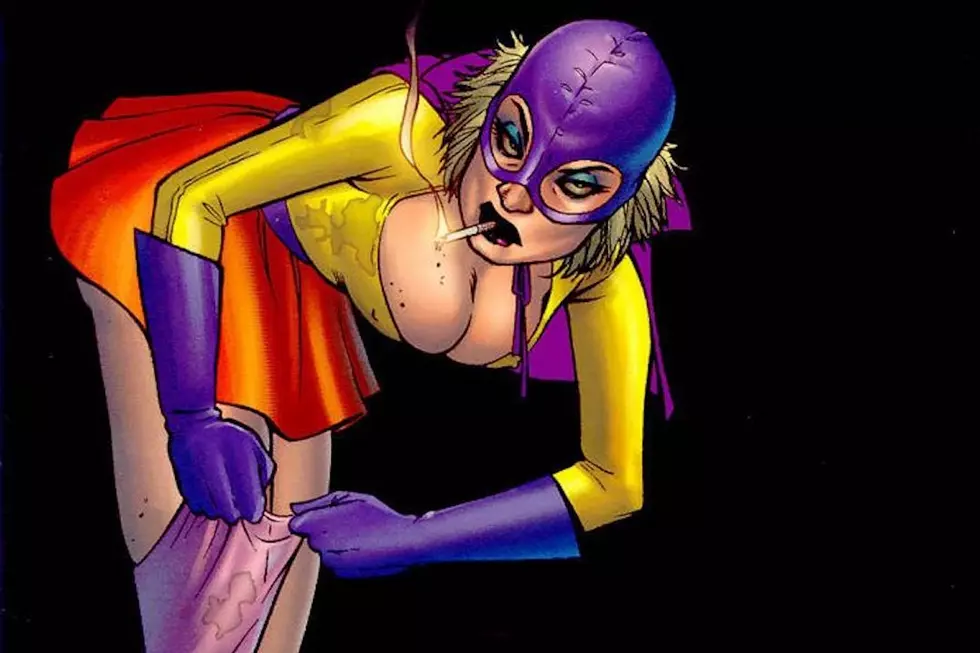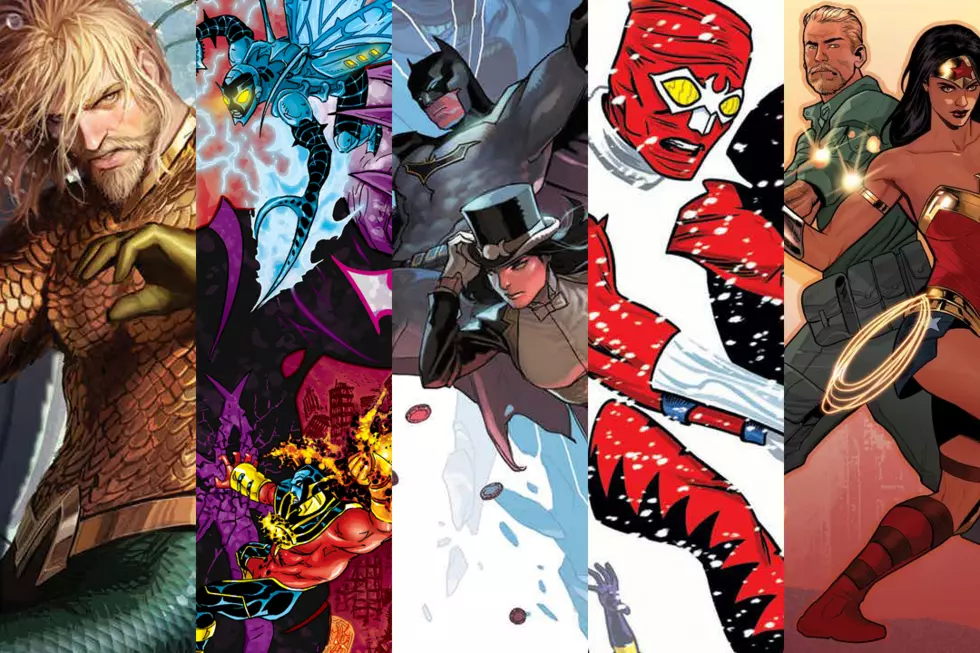
GET TO THE FLASHPOINT, WEEK 2: Frankenstein, Aquaman, Deathstroke, Citizen Cold

Flashpoint is DC Comics' summer event of 2011 that promises to change the DC Universe unrecognizably until the event's climactic finale, when the DC Universe will instead be left changed somewhat recognizably. In support of the event, DC is releasing 60+ issues of comic books across 22 titles in just three months. You'd have to be deranged to expend the time, effort and money to follow it all, but fortunately for you, ComicsAlliance has never been particularly whole in the sanity department. Over the next few months we'll be reading every single Flashpoint tie-in so we can tell you what's good, what's bad, and what is going on.
This week in GET TO THE FLASHPOINT, we look at
- Frankenstein and the Creatures of the Unknown by Jeff Lemire and Ibraim Roberson
- Emperor Aquaman by Tony Bedard, Ardian Syaf and Vicente Cifuentes
- Deathstroke and the Curse of the Ravager by Jimmy Palmiotti, Joe Bennett and John Dell
- Citizen Cold by Scott Kolins
FRANKENSTEIN AND THE CREATURES OF THE UNKNOWN - RECOMMENDED

After all the doom and gloom last week about how much worse the Flashpoint Universe is than the normal DCU, this week gives us the first clear example of one way that this alternate reality is better. In the Flashpoint Universe, World War II ended when Frankenstein's Monster found Adolf Hitler hiding in his bunker and cut him down with a two-handed sword. I mean, it's not explicitly stated that the war ends right after this, but I have to imagine that when a gigantic green figure from a classic horror novel cuts down your nation's leader with the blade of the archangel Michael, that's pretty much war over right there.
Tragically, America is not yet ready for a monster as its national hero, and Frankenstein is forcibly preserved in stasis by a fearful and yet also supremely douche-tastic U.S. military official. Also chucked into liquid-filled glass science tubes and forgotten are his fellow Project M commandoes, vampire Vincent Velcoro, wolfman Warren Griffith, and she-creature from the black lagoon Nina Mazursky. Stored in a basement and forgotten as one might misplace a cardboard box of old GI Joes, they break free when Frank finally regains consciousness in 2011.
With Lemire already announced as the writer on Frankenstein: Agent of Shade for DC's relaunch, this is another series that's more paving the way toward DC's new status quo than it is really connecting to Flashpoint, at least so far. And it's also easily the best Flashpoint tie-in book out this week. Lemire sets up a good team dynamic, with the noble and stoic Frankenstein supported by Velcoro, who's selfish and bloodthirsty; Griffith, who's as much loyal hound as savage wolf; and Mazursky, who as daughter of the scientist behind Project M is the group's last remaining connection to the science that created this new incarnation of DC's old Creature Commandos. As they set off to find her father's old hidden lab in Gotham, they're pursued by the daughter of their old commanding officer, Lt. Shrieve. She's capable monster hunter in her own right who demonstrates it by violently ending what's likely to be Manbat's only brief Flashpoint appearance.





EMPEROR AQUAMAN

Bedard, Syaf and Cifuentes' book gives readers the first insider perspective on the fierce war between the Atlanteans and the Amazons that threatens to envelop and destroy the entire Earth. As mentioned in last week's issue of World of Flashpoint, Aquaman and Wonder Woman were going to get married to solidify a political alliance between the two groups, but then Wonder Woman's mother was killed and the marriage was called off in favor of war. It's mentioned, but not by any of the Atlanteans himself, that Aquaman probably had Hippolyta assassinated, although it's not clear why. My current guess is she forced her daughter to wear pants at the wedding and Aquaman just lost it.
Thos issue also gives backstory on Atlantis' war against Western Europe, seen through flashbacks to events about a year before the events of Flashpoint, right as the war was beginning. Aquaman formed an alliance with Brian Markov, king of Markovia and known to the regular DC Universe as the superhero Geo-Force. But this was only done to capture Markov and use him to power Atlantis' secret weapon, a geo-pulse emitter that sunk France and Italy into the sea. The device as so far failed to do the same to Themyscira due to the intervention of Markov's sister, Tara.
We also see Mera in these flashbacks, and although we don't see her death in the book it's made pretty clear that the variant cover to last week's Flashpoint #2 -- featuring Wonder Woman holding up the creepy, pupil-less severed head of Mera (free of gore and with a fresh coat of make-up) -- was not meant to be a metaphorical expression of the bad blood between the two nations. It's interesting that the helmet we see Mera's not-yet-unattached head wearing in the flashbacks might very well be the same helmet Wonder Woman has been shown to wear in the present.
Honestly, the book's very info-heavy, feeling more like a history lesson about the Flashpoint Universe than a story. It doesn't help that it ends with a promise of "Next: The Secret Origin of Emperor Aquaman". I'm hesitant to get positive about the pacing of a three issue miniseries where the first book is the introduction and the second book promises to tell the character's origin story.


DEATHSTROKE AND THE CURSE OF THE RAVAGER

While the Amazons and Atlanteans are fighting, pirates and looters are fighting over the scraps that remain. Strongest among them is Deathstroke in Deathstroke and the Curse of The Ravager. Set prior to the Deathstroke events in last week's Flashpoint #2, the first issue of this tie-in introduces Deathstroke as a modern day pirate captain looking for treasure in the ruins of sunken Western Europe. At least that's what his crew's in it for. He's driven to find his missing daughter, Rose, lost in the chaos of the war and now on her way to a metahuman lab in Norway.
Bennet and Dell's art have turned Deathstroke into a hybrid of his superhero costume and the Gorton's fisherman out for bloody vengeance. He looks pretty badass through most of his killing and torturing. His sword looks a bit odd, though, with the extended tines on its hilt making it look like a life-size version of a He-Man action figure's blade. But the sword's biggest problem is that no matter how much blood it sheds, none of that blood belonged to Hitler and so it's by default not the best sword seen in Flashpoint this week.
The issue wraps up by bringing us to the point when we saw Deathstroke in Flashpoint, face to face with Aquaman and his trident. Still unclear is whether the titular "Curse of the Ravager" refers to Deathstroke's ship's name, his daughter, or something else entirely, and whether it's an actual curse, like the Curse of the Black Pearl, or more of a superstition like the Curse of the Bambino or the Curse of the Billy Goat. Note to DC: I would totally read a "Deathstroke and the Curse of the Billy Goat" miniseries, in which loyal Chicago Cubs fan Slade Wilson's increasing anger with his hapless team can only be calmed by ever more brutal assassinations.




CITIZEN COLD

In the alternate reality of Flashpoint, longtime Flash Rogue Captain Cold Len Snart is instead Citizen Cold, hero and defender of Central City. Although Cold's not the most virtuous of heroes. He's in it for the money, the sponsorships, the women, and not least of all the opportunity to engage in consequence-free violence. He has his own Rogues' Gallery of Weather Wizard, Fallout, Trixter, Heat Wave and Mirror Master. But his biggest threat comes from the possibility that someone will reveal the dark secret he hides, his true identity and the criminal past behind it.
The most likely candidates to find the truth appear to be journalists Iris and Wally West. Wally wears a uniform and drives a car that look like the products of what would happen if the design philosophy behind Tron: Legacy had sex with the design philosophy behind Green Arrow's Smallville costume. Wally comes close to the truth about Cold only to be caught and frozen by before he can reveal it.
To be honest, I had a little trouble getting into this one. To begin with, it spent a lot of time focusing on Flashpoint versions of minor characters we barely care about in the normal DC Universe. The larger problem, though, was that Snart's big fear of being found out felt hollow. Cold doesn't exactly have a nice-guy image he's trying to preserve. He straight up kills Mr. Freeze by stomping on his head while a crowd of ordinary Central City citizens cheers him on in the book's opening. If they're already giving him that kind of reception while he commits murder against a defenseless head-in-a-jar in full public view, I'm pretty sure they're not going to care about his reputation. The public in our real world has forgiven the crimes of celebrities ranging from Charlie Sheen to Mike Tyson to Martha Stewart to Roman Polanski, and none of them ever became vigilante fighters as part of their image rehabilitation. I'm confident somebody as evidently popular as Cold is could survive his name being dragged through the mud. And given that Flashpoint's world is so desperate for heroes, it doesn't seem like the people of Central City will care what Cold did as long as he's willing to keep fighting, and yes, killing, people on their behalf.
Citizen Cold's problem is that while other Flashpoint books treat their alternate reality characters as new individuals with different backgrounds, this series still treats the characters like their normal DCU counterparts, just thrown into a new setting. It's assumed we'll root for Wally because we know him as the Flash, but we barely get to see him at all here. It's assumed that we believe Cold is ashamed of his past as a villain, but we don't really know what the past entails. Wally calls Snart a "two-bit hood with a mile-long rap sheet", but that doesn't suggest the kind of career of super-villainy Cold had in the normal DCU. Even with his suspect methods, it seems like Cold's done, on balance, more good than harm here, which means either there's something that hasn't been revealed yet or he's overreacting. This book just isn't sure how distinct of an alternate reality it wants to present. When every other Flashpoint title is sending the message "these are not the familiar characters you're used to, and you have to learn to change your expectations", Citizen Cold's assumption you're going to instantly feel the same way about all its characters is disorienting.




Next week in GET TO THE FLASHPOINT: Wonder Woman, Grodd, the Legion of Doom, and Deadman and the Flying Graysons!
More From ComicsAlliance

![How Conner And Palmiotti Reinvigorated Harley And Reimagined ‘The Jetsons’ [Interview]](http://townsquare.media/site/622/files/2017/03/Harley-Featured.png?w=980&q=75)



![Kamandi Skips The Con, But Still Has A Weird Time In San Diego In ‘The Kamandi Challenge’ #3 [Exclusive]](http://townsquare.media/site/622/files/2017/03/Kamandi00.jpg?w=980&q=75)



